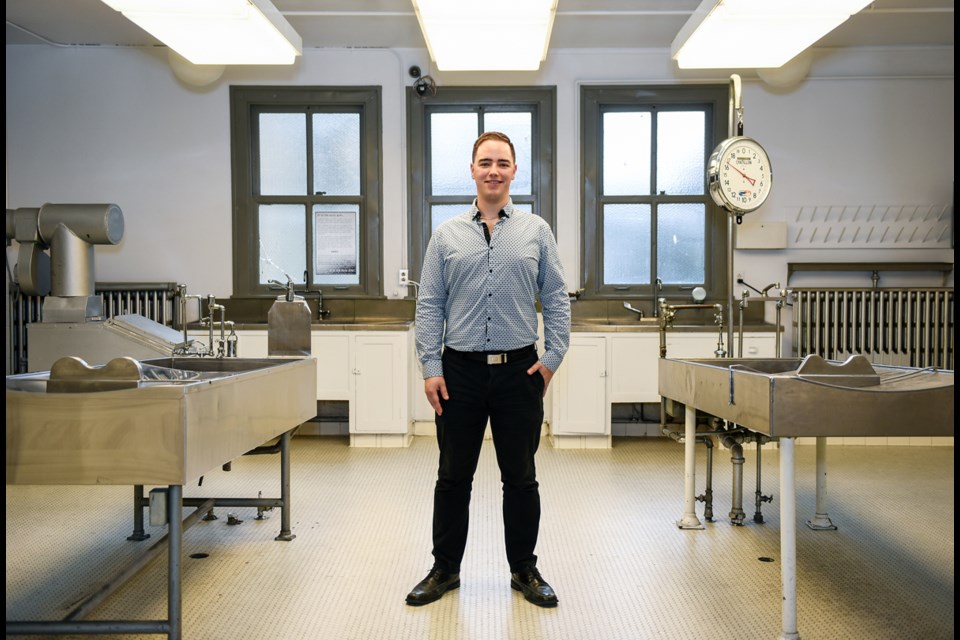There’s so much information packed into a short hallway at the Vancouver Police Museum. The space is about three-and-a-half feet wide and 20 feet long and is home to the museum’s newest permanent exhibition, Bridging the Gap: Vancouver’s Youth and the Law, which opened Saturday.
The physical size of the exhibition is in contrast to the mountain of facts; its creators layered stories so well that it could possibly be the most informative hallway in the city.
Underneath four electrostatic screens on the wall, a timeline winds its way from 1905 when the most common youth crime was incorrigibility (often blamed on “drunkenness and loose living on the part of the father”) to 2015 when youth crime is mostly shoplifting, assault and drug possession. The timeline reflects changes in youth crime trends, adapting legislation and policing in Vancouver.
As a bonus feature, the timeline is bookended with two tablet computers where people can play Caught in the Act, a video game produced by local company A.C.R.O.N.Y.M. Digital, where players can commit crimes in 1950, 1970, 1990, or 2010. Crimes are set locally and can, for instance, involve stirring up trouble at the Rolling Stones concert at the Coliseum, or assaulting a senior in Stanley Park. Players are always busted at the game’s end, and the consequences are the actual judicial sentences of each era.
There’s more. The hallway has a graffiti mural by local artist Larissa Healey, otherwise known as Gurl Twenty Three, who is a facilitator with RestART, a Vancouver graffiti management program that works with inner city youth. There are also a bunch of “Hello my name is” stickers people can sign, in a nod to New York street artists who, during in the 1980s, avoided trouble by slapping a wall with their art on a sticker.
Finding space for new exhibitions (there’s another opening later this year on policing in a diverse city) is a challenge for the self-funded museum. While the oldest police museum in North America has roots that go back to 1921, it attracted attention in 1986 when it moved into the Downtown Eastside heritage building that once held the courtroom, coroner’s office and city morgue, which means it isn’t exactly open plan.
James Highet is the programmer with the Vancouver Police Museum and one of his favourite things about his job, he said, is shifting perceptions.
“My hope for this exhibit is that it will break down some of the barriers between police and youth,” he said. “The rest of us look at teenagers as a totally different species — they’re them and we’re us. And so you can imagine how they feel about us, and how they feel in the presence of a uniform. It’s very rare for a teenager to look at somebody in a uniform and say, ‘That’s somebody I can go talk to, that’s somebody I can ask for help, or ask questions if I need.’”
Like any great historian, Highet has a knack for finding threads of commonality throughout time. One of his favourite stops in the museum is not its famous naturally-lit morgue and autopsy rooms, but in front of an old backlit photograph of Vancouver’s first police chief John Stewart standing in front of a tent, which was City Hall. This was in 1886 and the city had issues with drug addiction (the drug of choice, then, was whiskey). “When we talk about poverty or drugs in the city, we sometimes think it started in the ’60s or the ’70s,” Highet said. “But no, this is something the very first police department and the very first city council recognized.”
The VPD is the first police force in the country to hire female officers. Constables Lurancy Harris and Minnie Miller were hired June 19, 1912 to deal with female prisoners and youth. “They were the first police in Vancouver to reach out to youth on the street,” said Highet. “The first outreach in schools, talking to kids about organized crime — a lot of these programs you see today, started with these two female constables.”
It was, again, another female VPD officer who brought the idea for the museum’s new exhibition to director Rosslyn Shipp and Kristin Hardie.
Const. Mariya Zhalovaga, who once volunteered and worked for the museum as a summer student, and now connects with youth through various VPD programs, visited the exhibition on opening day.
“It feels amazing,” she said as she looked over it from a nearby doorway. “I’m so excited the public will finally be able to see this. Rosslyn and Kristin put so much work into the exhibition and I’m so pleased, and so thankful, they were able to fulfill my dream.”
@rebeccablissett



